|
The Dalton Gang's Last Raid, 1892
Around 9:30 the morning of October 5, 1892 five
members of the Dalton Gang (Grat Dalton, Emmett Dalton, Bob Dalton, Bill Power
and Dick Broadwell) rode into the small town of Coffeyville, Kansas. Their objective
was to achieve financial security and make outlaw history by simultaneously
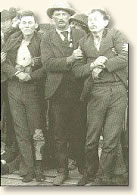
After the battle
townspeople display
the bodies
of Bob & Grat Dalton |
robbing
two banks. From the beginning, their audacious plan went astray. The hitching
post where they intended to tie their horses had been torn down due to road repairs.
This forced the gang to hitch their horses in a near-by alley - a fateful decision.
To disguise their identity, (Coffeyville was the Dalton's hometown) two of the Daltons wore false beards and wigs. Despite this, the gang was recognized as they crossed the town's wide plaza, split up and entered the two banks. Suspicious townspeople watched through the banks' wide front windows as the robbers pulled their guns. Someone on the street shouted, "The bank is being robbed!" and the citizens quickly armed themselves - taking up firing positions around the banks.
The ensuing firefight lasted less than fifteen minutes. A brief moment in time in which four townspeople lost their lives, four members of the Dalton Gang were gunned down and a small Kansas town became part of history.
David Elliott was editor of the local newspaper and published a detailed account soon after the gun battle. We pick up his story as the desperadoes dismount and head towards their targets:
"...After crossing the pavement the men quickened
their pace, and the three in the front file went into C.M. Condon & Co.'s bank
at the southwest door, while the two in the rear ran directly across the street
to the First National Bank and entered the front door of that institution. The
gentleman [the observer]
was almost transfixed with horror. He had an uninterrupted view of the inside of Condon and Co.'s bank, and the first thing that greeted his vision was a Winchester in the hands of one of the men, pointed towards the cashier's counter in the bank. He quickly recovered his lost wits, and realizing the truth of the situation, he called out to the men in the store that 'The bank is being robbed!' Persons at different points on the Plaza heard the cry and it was taken up and quickly passed around the square.
At the same time several gentlemen saw the two men enter the First National Bank, suspecting their motive, followed close at their heels and witnessed them 'holding up' the men in this institution. They gave the alarm on the east side of the Plaza. A 'call to arms' came simultaneously with the alarm and in less time than it takes to relate the fact a dozen men with Winchesters and revolvers in their hands were ready to resist the escape of the unwelcome visitors."
As the townspeople arm themselves, the desperados enter the two banks - Bill Powers, Dick Broadwell and Grat Dalton the C.M. Condon bank, Bob and Emmett Dalton the First National. Inside the Condon Bank, three employees are forced at gunpoint to fill a sack with money. One brave teller declares to the robbers that the vault has a time lock and can't be opened for another 10 minutes (this was untrue.) The robbers decide to wait, however their plan is interrupted as the townspeople open fire:
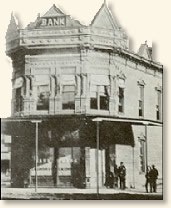
The C.M. Condon Bank |
"...Just at this critical juncture the citizens opened fire from the outside [of the Condon Bank] and the shots from their Winchesters and shot-guns pierced the plate-glass windows and rattled around the bank. Bill Powers and Dick Broadwell replied from the inside, and each fired from four to six shots at citizens on the outside. The battle then began in earnest. Evidently recognizing that the fight was on, Grat Dalton asked whether there was a back door through which they could get to the street. He was told that there was none. He then ordered Mr. Ball and Mr. Carpenter [two bank employees] to carry the sack of money to the front door. Reaching the hall on the outside of the counter, the firing of the citizens through the windows became so terrific and the bullets whistled so close around their heads that the robbers and both bankers retreated to the back room again. Just then one at the southwest door was heard to exclaim: ' I am shot; I can't use my arm; it is no use, I can't shoot any more.' "
A similar scene played out at the First National where Bob and Emmett Dalton forced the bank's employees to fill their sack with money. Using the employees as shields, the robbers attempted to escape the bank, only to be driven back inside by heavy gunfire:
"...He [Bob Dalton] then ordered the three bankers to walk out from behind the counter in front of him, 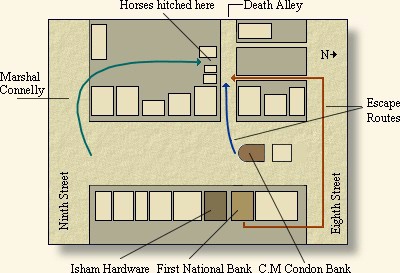 and they put the whole party out at the front door. Before they reached the door, Emmett called to Bob to 'Look out there at the left.' Just as the bankers and their customers had reached the pavement, and as Bob and Emmett appeared at the door, two shots were fired at them from the doorway of the drug store… Neither one of them was hit. They were driven back into the bank… Bob stepped to the door a second time, and raising his Winchester to his shoulder, took deliberate aim and fired in a southerly direction. Emmett held his Winchester under his arm while he tied a string around the mouth of the sack containing the money. They then ordered the young men to open the back door and let them out. Mr. Shepard complied and went with them to the rear of the building, when they passed out into the alley. It was then that the bloody work of the dread desperadoes began." and they put the whole party out at the front door. Before they reached the door, Emmett called to Bob to 'Look out there at the left.' Just as the bankers and their customers had reached the pavement, and as Bob and Emmett appeared at the door, two shots were fired at them from the doorway of the drug store… Neither one of them was hit. They were driven back into the bank… Bob stepped to the door a second time, and raising his Winchester to his shoulder, took deliberate aim and fired in a southerly direction. Emmett held his Winchester under his arm while he tied a string around the mouth of the sack containing the money. They then ordered the young men to open the back door and let them out. Mr. Shepard complied and went with them to the rear of the building, when they passed out into the alley. It was then that the bloody work of the dread desperadoes began."
Many of the townspeople gathered in Isham's Hardware Store near the banks. Not only did the unarmed citizens get rifles, shotguns, and ammunition, but the store also provided an excellent view of the two banks and the alley where the gang had tied their horses:
"...The moment that Grat Dalton and his companions,
Dick Broadwell and Bill Power, left the bank [the
C.M. Condon Bank] that they had just looted, they
came under the guns of the men in Isham's store. Grat Dalton and Bill Powers
each received mortal wounds before they had retreated twenty steps. The dust
was seen to fly from their clothes, and Powers in his desperation attempted to
take refuge in the rear doorway of an adjoining store, but the door was locked
and no one answered his request to be let in. He kept his feet and clung to his
Winchester until he reached his horse, when another ball struck him in the back
and he fell dead at the feet of the animal that had carried him on his errand
of robbery.
Grat Dalton, getting under cover of the oil tank, managed to reach the side of a barn that stands on the south side of the alley... [At this point, Marshal Connelly ran across a vacant lot into "Death Alley" from the south to the spot where the bandits had tied their horses.] The marshal sprang into the alley with his face towards the point where the horses were hitched. This movement brought him with his back to the murderous Dalton, who was seen to raise his Winchester to his side and without taking aim fire a shot into the back of the brave officer. Marshal Connelly fell forward on his face within twenty feet of where his murderer stood.
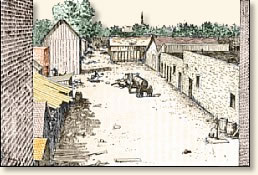
Death Alley - from a contemporary illustration
The gang tied their horses at the middle, left |
Dick Broadwell in the meantime had reached cover in the
Long-Bell Lumber Company's yards, where he laid down for a few moments. He was
wounded in the back. A lull occurred in the firing after Grat Dalton and Bill
Power had fallen. Broadwell took advantage of this and crawled out of his hiding-place
and mounted his horse and rode away. A ball from Kloehr's [John
Kloehr, a townsman] rifle and a load of shot from
a gun in the hands of Carey Seaman overtook him before he had ridden twenty feet.
Bleeding and dying he clung to his horse and passed out of the city… His dead
body was subsequently found alongside of the road a half-mile west of the city.
[As Marshal Connelly fell, Bob and Emmett Dalton - successfully escaping the First National Bank - ran down a side alley and into 'Death Alley' from the north.] When the two Daltons reached the junction of the alleys they discovered F.D. Benson in the act of climbing through a rear window with a gun in his hand. Divining his object, Bob fired at him point blank at a distance of not over thirty feet. The shot missed Mr. Benson, but struck a window and demolished the glass. Bob then stepped into the alley and glanced up towards the tops of the buildings as if he suspected that the shots that were being fired at the time were coming from that direction. As he did so, the men at Isham's took deliberate aim at him from their position in the store and fired. The notorious leader of the Dalton gang evidently received a severe if not fatal wound at this moment. He staggered across the alley and sat down on a pile of dressed curbstones near the city jail. True to his desperate nature he kept his rifle in action and fired several shots from where he was seated. His aim was unsteady and the bullets went wild… He arose to his feet and sought refuge alongside of an old barn west of the city jail, and leaning against the southwest corner, brought his rifle into action again and fired two shots in the direction of his pursuers. A ball from Mr. Kloehr's rifle struck the bandit full in the breast and he fell upon his back among the stones that covered the ground where he was standing.
After shooting Marshal Connelly, Grat Dalton made another attempt to reach his horse. He passed by his fallen victim and had advanced probably twenty feet from where he was standing when he fired the fatal shot. Turning his face to his pursuers, he again
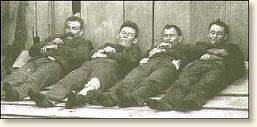
After the battle - Bill Power, Bob Dalton,
Grat Dalton and Dick Broadwell |
attempted to use his Winchester. John Kloehr's rifle spoke in unmistakable tones another time, and the oldest member of the band dropped with a bullet in his throat and a broken neck.
Emmett Dalton had managed to escape unhurt up to this time. He kept under shelter after he reached the alley until he attempted to mount his horse. A half-dozen rifles sent their contents in the direction of his person as he undertook to get into the saddle… Emmett succeeded in getting into the saddle, but not until he had received a shot through the right arm and one through the left hip and groin. During all this time he had clung to the sack containing the money they had taken from the First National Bank. Instead of riding off, as he might have done, Emmett boldly rode back to where Bob Dalton was lying, and reaching down his hand, attempted to lift his dying brother on the horse with him. 'Its no use,' faintly whispered the fallen bandit, and just then Carey Seamen fired the contents of both barrels of his shot-gun into Emmett's back. He dropped from his horse, carrying the sack containing over twenty thousand dollars with him, and both fell near the feet of Bob, who expired a moment thereafter."
References:
Elliott, David Stewart, Last Raid of the Daltons and Battle With the Bandits (1892), Horan, James D. and Paul Sann, Pictorial History of the Wild West (1954).
How To Cite This Article:
"The Dalton Gang's Last Raid, 1892" EyeWitness to History, www.eyewitnesstohistory.com (2001).
|






